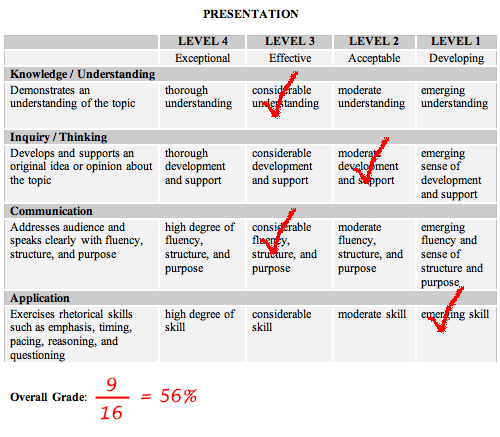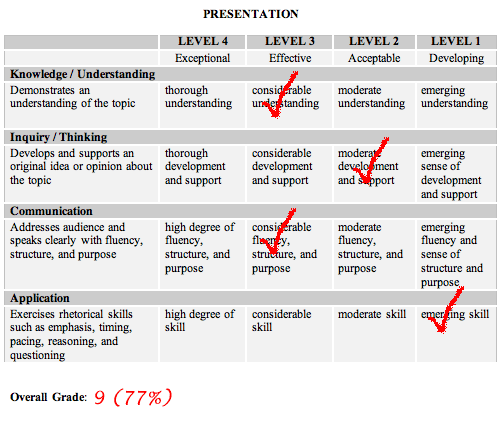What are rubrics?
Rubrics are great tools to help assess student learning. Teachers everywhere are using rubrics to guide teaching and learning. Yet even the most experienced teachers commonly misinterpret rubric scores! Unknowingly, they are short-changing their students. So, are you using rubrics properly? Keep reading to find out.
Go to Rubric Converter NowRubrics are organized according to performance levels and assessment criteria. Rubrics with four or five levels are most common. The criteria included in the assessment vary widely, depending on the assignment and what skills the teacher is assessing.
How do rubric scores relate to percent grades?
Let's take a rubric with four levels and four criteria as an example. If a student's performance is at the bottom level (Level 1), that means the student has met basic expectations in a limited or unsatisfactory way. This effort should be considered a minimum passing grade. In the US, a minimum passing grade is generally 60%, so your student should receive a 60% for this assignment.
Likewise, if a student's performance is at the top level (in this case, Level 4), that means the student has met or exceeded expectations in an exceptional way. For this excellent effort, a student should receive the highest possible grade, usually 100%.
How do teachers make a simple error when converting to percent grades?
The problem is that a huge number of teachers are misusing and misinterpreting rubric scores. Forgetting that the lowest performance level represents a minimum pass, they are wrongly equating this bottom level with complete failure. That means that countless students are receiving failing grades when they deserve to be passing!
Consider the following example of a rubric that has been scored improperly.
The Wrong Way

Does this look familiar? The teacher has added up the total score (here, 3 + 2 + 3 + 1 = 9 points), and simply divided this result by the maximum score (4 x 4 = 16 points). This is the way many teachers convert a rubric score into a percent grade. This method is wrong.
Think about it. In the above example, the student has scored well above the bottom level of performance, yet he or she has received a failing grade of 56%. Clearly that doesn't make sense.
Below is an example from a teacher who knows how to make this conversion.
The Right Way

What's the difference between the right way and the wrong way?
Look at the discrepancy between the "Wrong Way" and the "Right Way". Whereas in the first case the student received a failing grade of 56%, in the second case he or she has received a passing grade of 77%. That's a big difference.
So what is the correct way to convert a rubric score into a percent grade?
That depends on several factors, including the number of levels in your rubric, the number of assessment criteria, and your minimum passing grade. To make the correct conversion, you must consider these factors for each rubric, and create a mathematical equation that will allow you to map a score on your rubric to a percent grade. Then you must apply the equation to each possible rubric score to determine the equivalent percent grade. That sounds like a lot of work, doesn't it?
Go to Rubric Converter NowHow can Roobrix help me avoid this mistake?
Fortunately you have Roobrix.com - the Rubric Converter. The Roobrix converter performs the calculations for you. All you need to do is specify a few parameters, including your student's rubric score, and you will be on your way to giving your students the passing grades they have rightfully earned.